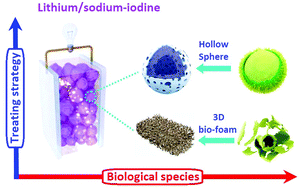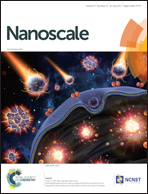Understanding the effects of 3D porous architectures on promoting lithium or sodium intercalation in iodine/C cathodes synthesized via a biochemistry-enabled strategy†
Abstract
Rechargeable sodium–iodine and lithium–iodine batteries have been demonstrated to be promising and scalable energy-storage devices, but their development has been seriously limited by challenges such as their inferior stability and the poor kinetics of iodine. Anchoring iodine to 3D porous carbon is an effective strategy to overcome these defects; however, both the external architecture and internal microstructure of the 3D porous carbon host can greatly affect the ion intercalation of iodine/C electrodes. To realize the full potential of iodine electrodes, a biochemistry-enabled route was developed to enable the controllable design of different 3D porous architectures, from hollow microspheres to 3D foam, for use in iodine/C cathodes. Two types of spores with spherical cells, i.e. Cibotium Barometz (C. Barometz) and Oetes Sinesis (O. Sinesis), are employed as bio-precursors. By carefully controlling the degree of damage on the bio-precursors, different targeted carbon hosts were fabricated. Systematic studies were carried out to clarify the structural effects on modifying the ion-intercalation capabilities of the iodine/C cathodes in lithium–iodine and sodium–iodine batteries. Our results demonstrate the profound performance improvements of both 3D bio-foam and hollow sphere because their hierarchically porous structures can strongly immobilize iodine. Notably, the 3D bio-foam based iodine composites achieve faster ion kinetics and enhanced rate capability than their hollow sphere based counterparts. This was attributed to their higher micro/mesopore volume, larger surface area and improved packing density, which result in the highly efficient adsorption of iodine species. By virtue of the thinnest slices, the iodine/bio-foam derived from C. Barometz spores achieves the best high-rate long-term cycling capability, which retains 94% and 91% of their capacities in lithium–iodine and sodium–iodine batteries after 500 cycles, respectively. With the help of the biochemistry-assisted technique, our study provides a much-needed fundamental insight for the rational design of 3D porous iodine/C composites, which will promote a significant research direction for the practical application of lithium/sodium–iodine batteries.



 Please wait while we load your content...
Please wait while we load your content...